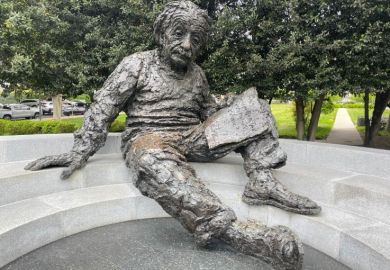Richard Gregory reflects on the mirror image in art and science
Jonathan Miller's book of his exhibition "Mirror Image", showing in the Sainsbury wing of the National Gallery, is a visual feast, focusing on the magic of mirrors and how reflections are represented in paintings. Here are all manner of mirror-pictures, from multiple views to self-portraits and much more besides, making for a richly rewarding experience. It is satisfying that this deservedly popular, though short-duration exhibition is preserved in a book of such a high standard.
Miller approaches his subject with enthusiasm and due wonder, through a text that must have presented problems on a par with those encountered by C. P. Snow in Two Cultures. For pictures to be admired and criticised as art is one thing, but for mirrors and reflections to be understood in terms of their relevant sciences is quite another. Properties of reflections, and just what they are, tease the enquiring mind with unfamiliar questions. Indeed, reflections and mirrors have confused thinkers from Plato to lmmanuel Kant, and present day philosophers and scientists are not immune to confusion. So would not an explanation of what a virtual image of a mirror is have been useful? Just as for normal reality, there are no mirror images without an eye or a camera. Look away from the mirror, and the image (unlike the real image of a slide projector) has gone. And we see reflected objects as behind the mirror, though we know they are in front. So there are multiple representations in the brain that do not tie up. Here perceptions and conceptions disagree, and neither can correct the other. The mixture of psychology and physics required to understand reflections can easily confuse, and some might argue that such explanations merely detract from the appreciation of art. This is not, however, Miller's view in On Reflection, although he has to tread a fine line between evocative art and explanatory science, and occasionally he does trip up.
Although Leonardo da Vinci advised young painters to "take the mirror as your master, that is a flat mirror, because on its surface things in many ways bear a resemblance to paintingI", reflections and paintings are, as Miller appreciates, quite different. Thus, the surface of a perfect mirror is invisible - and yet is "seen" - as though postulated by the brain to explain why this region of reality is in a wrong place. The most famous examples of mirror confusion are the many inappropriate answers that have been suggested to the question: Why does a looking-glass reflect (for example a book) right-left reversed, yet not upside down? Generally an E looks peculiar, while a W looks normal. The puzzle comes from mirrors being optically symmetrical, although (according to Curie's Principle) systematic asymmetry cannot be produced from symmetry. So how can a vertical, optically symmetrical mirror placed across the line of sight, reverse sideways yet not up-down? For Kant this problem was too difficult for the human mind to grasp.
But once one sees what kind of problem it is, the answer is quite easy to see. The image reversal is produced by rotating the object, or oneself, to face the mirror. Jonathan Miller is right in saying that the reversal is not produced by the mirror, and he hints at the answer, but unfortunately he adds that the image is "uncontroversially" the right way up. This is not so, it does not have to be upright, or right-left reversed. Try looking at a book and then rotate it to face a mirror behind it - but not, as usual, by rotating the book around its vertical axis. Try rotating it around its horizontal axis to face the mirror. Now the book appears in the mirror upside down (which it is) but not right-left reversed. The reversal is given by the rotation of the object: a different rotation gives a different reversal. Mirror images are usually right-left reversed, as we usually rotate things (because of gravity) around a vertical axis. But there is nothing special about this. We can stand things (including ourselves) on their heads, giving upside-down and not right-left reversed reflections. This explanation, though not technical, does require thought. Do such explanations interfere with experiences of paintings and mirrors, or do they add? I would have preferred more.
Many intriguing properties of mirrors go unmentioned, despite their importance in normal life, especially for artists. As the image is as far behind the mirror as the object is in front, the artist sees the sitter as much smaller in the mirror than seen directly. This makes mirror images disappointingly small, so understandably artists often "cheat" by enlarging painted reflections to the same size as the subject. This is so in many famous paintings, such as Diego Velasquez's, and no doubt they gain from this violation of optics. Not mentioned is the surely useful fact for self-portraiture that right-left reversal can be cancelled - so the artist can see himself or herself as others see them - by using two mirrors touching at right angles, forming a mirror-corner. There will be a thin vertical crack between them but this is not confusing. This might have saved Rembrandt the trouble of having to repaint his self-portrait, which now hangs in Kenwood House in Hampstead, to make himself appear, correctly, right-handed.
It is amusing, and for many people surprising, that if one traces the outline of one's head on the glass of a mirror with lipstick or a felt pen, the image of one's head continues to fill it exactly - from whatever distance one views one's reflected head in its drawing on the glass. Perhaps it is better known that one needs a mirror at least half one's height and width to see the whole of oneself. It does not help to walk backwards from a smaller mirror.
Such surprises (and for many people they are surprises) show up not so much with mirror paintings as with mirrors viewing normal objects. Very likely it is because mirror images cannot be explored by touch, as normal objects can, that they are so confusing and mysterious. For to understand - as children and scientists learn to understand - by discovery, we must go through "mirrors of appearance", to explore by interacting with objects. So mirrors and pictures, as well as television and computer screens, have limitations for revealing reality.
Perhaps appropriately, while there is a need to relate art more closely to science, Miller does not discuss such everyday properties of mirrors or the amazing properties of light and matter for producing reflections. One may think that light simply bounces off shiny metal - but no. Light penetrates the metal and is re-created by a weird dance of electrons in the mirror. So what we learn at school, that "the angle of incidence equals the angle of reflection" or that light takes the path of shortest time, is by no means obvious. What happens in the mirror has only recently been explained by physicists through quantum electro dynamics, which I for one only partly understand. But it is fun to try.
With his superb selection of pictures, Miller concentrates on the views and interests of artists and lovers of painting, sometimes guessing at answers to questions that have been investigated by years of experimental research. He touches on cognitive processes of perception that are in a specialised province of the mind-brain sciences. But as these processes are not in consciousness, they must be discovered by experiment, and they are often surprising.
Miller points out interesting phenomena of vision with somewhat guessed explanations, despite the existence of a vast, if generally unknown scientific literature on perception and how we see transparency, which is highly illuminating for those who like this sort of thing. The international journal Perception recently devoted two issues to experiments on related subjective brightness effects, some having been familiar to artists for millennia but only now being explained. The problem is that the explanations are in terms that are unfamiliar (as for the physics of mirrors and reflections), and are difficult to grasp without dedicating considerable time to thought.
This raises the problem for any book attempting to cross art-science boundaries: experiencing and thinking are different and may not go well together. Admiring a sunset and at the same time thinking out why the sky is red, evokes different mind-brain processes, which few of us like to switch on simultaneously. Listening to a symphony on the radio, one may be puzzled that the different sounds of all those instruments can be conveyed by the vibrations of the single cone of the speaker. One may not want to bother with this while listening to the music, but surely it adds to life at least to see it as an intriguing question. And the answer - as for mirrors and reflection - is interesting. Some reviewers have criticised Miller for his leanings towards issues of science, claiming it detracts from the appreciation of the pictures. Indeed, explanations can make us see pictures, and everything else for that matter, in a very different light. But why not? Is it not fun to switch mental views? I would have preferred fuller and more careful explanations because the text sits in the art-science gap rather than bridging it. Possibly a bridge would have been impassable from either end, but the attempt would have been most interesting. Surely the trick is to live in at least two cultures, though not necessarily at the same time.
This is not a criticism of this attractive book, which bears the stamp of an individual mind with a discerning eye, it is simply a plea for more.
Richard Gregory is emeritus professor of experimental psychology, University of Bristol, and author of Mirrors in Mind. "Mirror Image" will be at the National Gallery until December 13.
On Reflection
Author - Jonathan Miller
Editor - National Gallery Publications
ISBN - 1 85709 236 8 and 237 6
Publisher - Yale University Press
Price - £25.00 and £14.95
Pages - 224
Register to continue
Why register?
- Registration is free and only takes a moment
- Once registered, you can read 3 articles a month
- Sign up for our newsletter
Subscribe
Or subscribe for unlimited access to:
- Unlimited access to news, views, insights & reviews
- Digital editions
- Digital access to THE’s university and college rankings analysis
Already registered or a current subscriber? Login



